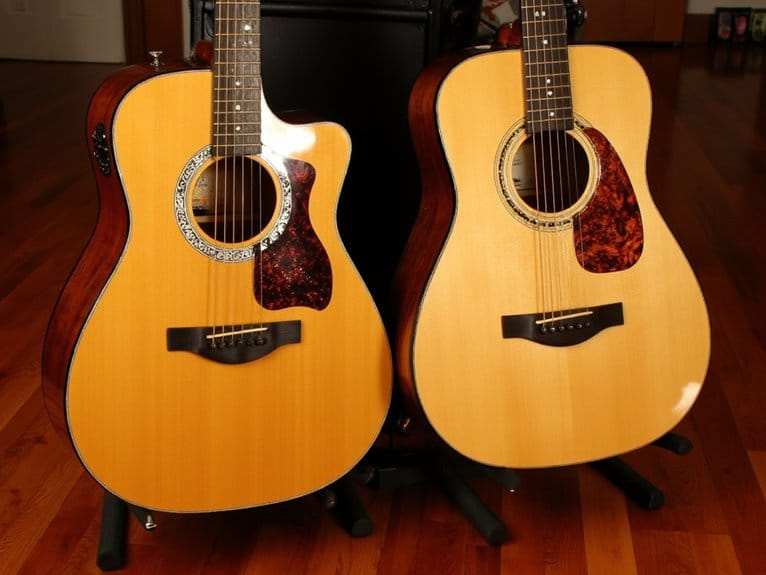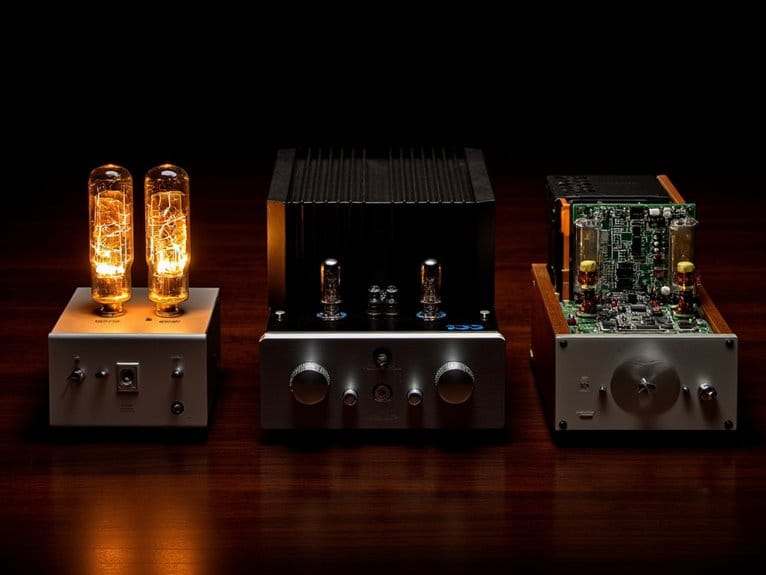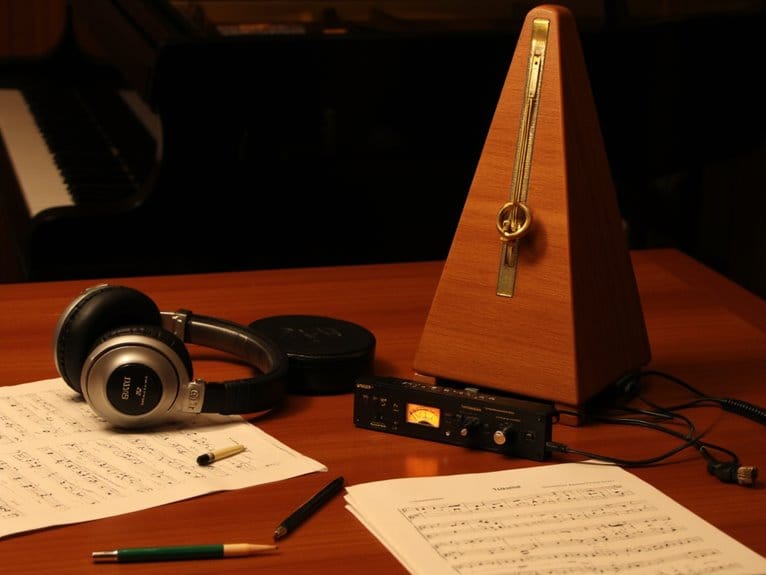Understanding Bass Guitar String Spacing and Comfort
Your bass guitar’s string spacing—the distance between adjacent string centers measured at the bridge—directly impacts your playing comfort and technique, with standards ranging from 16.5mm to 19mm depending on your instrument. Four-string basses typically maintain 19mm spacing for ideal finger independence, while five-string models narrow to 16-17mm to accommodate the additional string within reasonable neck width constraints. Wider spacing reduces hand strain and prevents accidental muting, though narrower configurations can enhance speed techniques, and there’s much more to evaluate when optimizing your setup.
We are supported by our audience. When you purchase through links on our site, we may earn an affiliate commission, at no extra cost for you. Learn more.
Notable Insights
- String spacing is measured between adjacent string centers at the bridge, typically ranging from 16.5mm to 19mm depending on bass configuration.
- Wider spacing improves finger independence and reduces string muting, while narrower spacing facilitates faster playing techniques and aggressive picking styles.
- Four-string basses generally use 19mm spacing, while five-string basses narrow to 16-17mm to maintain comfortable neck width proportions.
- Hand size, playing technique, and musical style determine optimal spacing, with jazz players preferring wider spacing and funk players benefiting from tighter configurations.
- String spacing can be adjusted using bridge saddles, and proper measurement with calipers ensures consistent setup for optimal playability and comfort.
What Is Bass Guitar String Spacing and How Is It Measured
Bass guitar string spacing is fundamentally the distance measured between the centers of adjacent strings.
String spacing fundamentally determines how your fingers navigate the fretboard and directly influences your bass playing technique and comfort.
While it might seem like a minor detail, I’ve found that this measurement markedly impacts everything from your playing comfort to your instrument’s tonal balance.
You’ll typically measure this distance at the bridge where the strings anchor, since that’s where spacing remains most consistent throughout your playing sessions.
The string spacing importance becomes evident when you consider how it affects your hand positioning, pickup alignment, and overall technique effectiveness.
For accurate measurements, you’ll need proper measuring tools like calipers, which provide precision when measuring from center to center of adjacent strings.
Though a quality ruler works adequately for basic assessments when calipers aren’t available.
However, measuring between string centers doesn’t account for the fact that bass strings have varying string diameters, which can create uneven visual spacing despite equal center-to-center distances.
String spacing also influences how well your bass responds to different pickup configurations, particularly affecting the balance between strings in single-coil and split-coil setups.
Proper string spacing alignment is crucial for optimal signal transmission, much like how oxygen-free copper conductors in quality instrument cables deliver clean signals without interference.
Standard spacing typically ranges from 16.5mm to 19mm, where narrower configurations facilitate quicker passages while wider spacings enhance finger placement accuracy.
To calculate the spacing per string, you’ll divide the total bridge length by the number of spaces between strings.
Standard String Spacing Dimensions Across Different Bass Models
When you’re shopping for a bass guitar, you’ll quickly discover that string spacing isn’t a one-size-fits-all specification, and the differences between models can greatly impact your playing experience, comfort, and technique development.
Most 4-string basses maintain the industry-standard 19mm spacing that I’ve found works well for both fingerstyle and pick playing, though you’ll encounter variations ranging from 18mm to 20mm depending on the manufacturer’s bridge design and target player preferences.
As you move into 5-string territory and beyond, manufacturers typically narrow the spacing to around 16-17mm to keep the neck width manageable, creating a noticeably different feel that some players love while others struggle to adapt to. This spacing consideration becomes particularly important when selecting replacement parts, as proper string spacing ensures that pickup pole pieces align correctly with the strings for optimal sound capture and performance.
Common 4-String Measurements
As someone who’s measured countless basses over the years, I can tell you that most 4-string instruments converge around a surprisingly consistent standard: approximately 19 millimeters (roughly 3/4 inch) between strings at the bridge.
This measurement, taken from the center of your lowest string to the center of your highest string and divided by three spaces, forms the backbone of modern bass design.
Fender Precision and Jazz basses popularized this specification, which Modulus and countless other manufacturers adopted as their benchmark. The slim “C”-shaped neck profile found on many modern instruments enhances this standard spacing for improved playability.
While you’ll occasionally find variations ranging from 16.5mm to 20mm on custom instruments, the 19mm standard optimizes both string comfort and balanced string tensions across the neck, making it suitable for everything from aggressive slapping to delicate fingerstyle work. Models like the Fender Squier Precision Bass guitar maintain this standard spacing while offering accessible pricing for developing players.
When considering budget instruments under $500, the neck comfort design becomes even more critical since many entry-level basses may require initial setup adjustments to achieve this optimal spacing.
Multi-String Bass Variations
Moving beyond the traditional four-string setup, I’ve found that multi-string basses present a fascinating engineering challenge where manufacturers must balance neck width, playability, and string clarity through increasingly sophisticated spacing decisions.
Five-string basses typically maintain comfortable spacing around 15-16mm per string, with bridge measurements reaching 3.10 inches, allowing players adequate finger room without excessive neck width.
Six-string configurations require tighter spacing, often 14-16mm, creating a compromise between accessibility and ergonomics that works surprisingly well for jazz and metal applications.
When you venture into 7 string ergonomics, spacing can exceed 19mm per string, demanding careful consideration of hand size and technique. Multi scale benefits become particularly valuable here, as fanned-fret designs optimize string tension while accommodating varying hand positions across the fretboard’s extended range.
Manufacturer Bridge Differences
The spacing innovations I’ve outlined for multi-string configurations stem directly from how different manufacturers approach bridge design, where you’ll find surprisingly varied interpretations of what constitutes “standard” dimensions even within traditional four-string models.
Fender maintains their classic 19mm spacing across vintage and modern lines, prioritizing consistency over customization, while companies like Hipshot revolutionize player feedback integration through fully adjustable features that accommodate diverse spacing preferences.
- Bridge material choices – brass for punchy lows versus aluminum for brighter highs – create tonal impact differences
- Ergonomic design variations range from fixed 19mm standards to customizable .656″-.822″ options
- Construction quality differs between CNC-machined precision and traditional stamped designs
- Compatibility issues arise when retrofitting adjustable bridges onto vintage-spec instruments
Many budget-friendly bass guitars feature fixed bridge designs that prioritize cost-effectiveness over adjustment flexibility, which can impact string spacing customization options for developing players.
How String Spacing Affects Your Playing Technique and Performance
Discovering how string spacing affects your bass playing technique will transform your understanding of why some basses feel effortless under your fingers while others seem to fight against your natural movements.
Wider spacing dramatically improves finger independence, allowing you to execute complex fingerstyle patterns without accidentally muting adjacent strings, while simultaneously promoting ergonomic positioning that reduces wrist strain during extended sessions.
However, narrower spacing favors speed-focused techniques, enabling lightning-fast single-note runs and aggressive picking styles. Your playing style dictates ideal spacing—slap techniques demand wider measurements for clean articulation, whereas tapping requires balanced separation that maintains reachable fretboard coverage.
Consistent spacing enhances performance reliability, supporting cleaner note articulation and reduced string noise, while proper measurements influence your plucking angle, directly affecting tonal character and dynamic control across various musical contexts. Professional bassists often complement their optimal string spacing setup with dual-channel preamps that provide both clean tones and aggressive distortion options for maximum versatility.
To further enhance your tone shaping capabilities, many bassists pair their string spacing preferences with quality bass preamps that offer comprehensive EQ controls and blend functions for optimal signal processing.
The Connection Between Neck Design and String Spacing
Three fundamental design relationships govern how your bass neck’s architecture directly influences string spacing effectiveness, creating an interconnected system where neck width, profile, and edge placement work together to determine both comfort and performance capabilities.
Bass neck architecture creates an interconnected system where width, profile, and edge placement determine your instrument’s comfort and performance capabilities.
Neck ergonomics fundamentally depend on these critical design preferences:
- Width-to-spacing correlation – Your neck width at the 12th fret typically matches bridge string spacing, establishing proportional dimensions that range from 1-3/4″ at the nut to over 2″ at the bridge.
- Profile influence on perception – C-shape, U-shape, or V-shape profiles affect how you perceive spacing even when measurements remain constant.
- Edge placement precision – Outer strings positioned approximately 0.125″ from neck edges guarantee symmetrical hand positioning and consistent string alignment.
- Spacing variation accommodation – Playability factors adapt to your needs, with spacing ranging from 16.5mm to 24mm center-to-center based on technique requirements.
Adjusting and Setting Up Your Bass Guitar String Spacing
Now that you understand how neck design influences string spacing, you’ll need to know the practical methods for adjusting your bass guitar’s bridge saddles to achieve ideal spacing and intonation.
I’ve found that proper measurement techniques, combined with systematic maintenance procedures, make the difference between a bass that fights you and one that feels perfectly dialed in.
Whether you’re working with adjustable bridge saddles or compensating for fixed spacing configurations, the setup process requires precision tools and a methodical approach to balance string height, lateral positioning, and intonation accuracy. Quality flatwound strings with hand-polished surfaces can significantly enhance your setup’s overall playability and reduce finger noise during precise adjustments.
Just as drummers rely on proper tuning stability when adjusting their snare drums for optimal performance, bass players must maintain consistent string positioning throughout their instrument’s setup process. Modern bass tuners with 19:1 gear ratios provide the fine adjustment control needed to maintain precise string tension during the entire setup procedure.
Bridge Saddle Adjustment Methods
Once you’ve got your bass guitar in hand and you’re ready to dial in that perfect string spacing, the bridge saddle adjustment process becomes your most powerful tool for achieving both comfortable playability and ideal tone.
Your saddle adjustment technique directly impacts how your strings feel under your fingers, while proper bridge stability guarantees consistent performance during aggressive playing sessions.
Here’s your systematic approach to mastering bridge saddle adjustments:
- Measure string gauge thickness to determine appropriate saddle positioning, moving each saddle back by its corresponding string diameter.
- Use precision rulers and gauges to maintain accurate distances between saddles and from nut to bridge.
- Adjust saddles gradually while checking spacing after each modification to preserve consistent gaps.
- Keep saddles parallel during height adjustments to prevent unwanted spacing changes that compromise playability.
When performing these adjustments, ensure your bass is properly supported on a guitar stand with adequate stability features to prevent accidental damage during the setup process. Remember that string gauge selection affects your bridge setup requirements, as standard 5-string sets typically range from .045 to .130 with heavier gauges offering more volume and sustain while requiring different saddle positioning considerations. The 34-inch scale length strikes an optimal balance between string tension and low-end punch, making proper saddle adjustment crucial for maintaining this fundamental design advantage.
Setup Measurement and Maintenance
Precise measurement forms the foundation of professional bass guitar setup, and I’ve learned that even experienced players often underestimate how dramatically accurate string spacing affects their instrument’s playability and tone.
When establishing proper string spacing, digital calipers provide the most reliable accuracy, measuring center-to-center distances at both the bridge and nut positions. I recommend documenting baseline measurements during initial setup, which simplifies future maintenance when strings become misaligned or components shift over time.
Essential tools techniques include marking nut slots with specialized spacing rulers, verifying measurements from pickup polepieces for ideal alignment, and checking compatibility before ordering replacement bridges or saddles. Professional audio interfaces with high-performing preamps require precise positioning to capture the nuanced tonal characteristics that proper string spacing contributes to bass guitar recordings.
Regular monitoring catches wear-related changes that could compromise comfort, intonation, and overall performance consistency. Similar to how string instruments like banjos may require adjustable truss rods for customized string height during their break-in periods, bass guitars benefit from periodic setup adjustments to maintain optimal spacing and playability. Just as true bypass functionality preserves signal integrity in compression pedals, proper string spacing maintains the natural resonance and tonal clarity of your bass guitar without unwanted interference.
Choosing the Right String Spacing for Your Playing Style
Why does string spacing matter so much when you’re selecting a bass guitar?
Your playing preferences and finger agility directly determine which spacing will enhance or hinder your technique, making this choice essential for long-term comfort and performance.
I’ve found that matching spacing to your style prevents frustration and physical strain.
Consider these key factors when selecting your ideal configuration:
- Funk and slap players benefit from wider spacing (18-19mm) for precise thumb placement and cleaner articulation.
- Metal and progressive players often prefer narrower spacing (16.5-17.5mm) for faster finger movements and reduced hand travel.
- Jazz musicians should prioritize ergonomic comfort that supports intricate chord work and scale passages. Just as with acoustic guitars, gauge selection significantly impacts playability and tone, with lighter gauges offering easier fretting while heavier gauges provide increased volume and projection.
- Session players need versatile spacing that adapts across multiple genres while maintaining technical demands.
Your hand size, technique preferences, and primary musical styles should guide this significant decision.
Just as string spacing affects your playing comfort, upgrading your pickup magnets can dramatically transform your bass’s tonal characteristics and output response.
Frequently Asked Questions
Does String Spacing Affect Intonation Accuracy Across Different Frets?
String spacing doesn’t directly affect intonation consistency across frets since fretboard geometry determines pitch accuracy. However, you’ll experience indirect effects through playing technique changes that can influence finger pressure and string fretting precision.
How Does String Spacing Impact Pickup Placement and Tone Quality?
String spacing directly affects your pickup alignment options and magnetic field interaction with individual strings. Wider spacing provides better tone variation per string, while narrower spacing creates more blended, less defined tonal characteristics in your mix.
On a final note
You’ve now got the essential knowledge to make informed decisions about string spacing, whether you’re purchasing your first bass or considering modifications to your current instrument. Remember, there’s no universally perfect spacing—what matters is finding the configuration that complements your technique, hand size, and musical goals. Don’t be afraid to experiment with different setups until you discover what feels most natural and enhances your playing performance.







